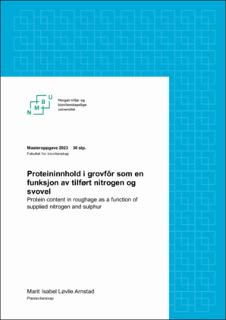| dc.contributor.advisor | Trine Aulstad Sogn | |
| dc.contributor.advisor | Tore Krogstad | |
| dc.contributor.advisor | Marit Jørgensen | |
| dc.contributor.author | Arnstad, Marit Isabel Løvlie | |
| dc.date.accessioned | 2023-07-19T16:28:23Z | |
| dc.date.available | 2023-07-19T16:28:23Z | |
| dc.date.issued | 2023 | |
| dc.identifier | no.nmbu:wiseflow:6839575:54592298 | |
| dc.identifier.uri | https://hdl.handle.net/11250/3080285 | |
| dc.description.abstract | Økt fokus på selvforsyning med norskbasert fôr til melkekyr førte til denne studien om S-tildeling til timoteibasert eng. For å sikre et grovfôr med nok proteiner og høy energiverdi til melkekyr er det viktig med riktig gjødsling. Oppgaven er knyttet opp mot et prosjekt til Norsk institutt for bioøkonomi (NIBIO) som utføres i samarbeid med Norsk Landbruksrådgivning (NLR). I prosjektet blir det testet hvordan ulike nitrogen (N)- og svovel (S)-mengder kombinert med husdyrgjødsel (HG) påvirker avling og kvalitet i timoteibasert eng i tre regioner i Norge. Denne oppgaven bygger på data fra hovedsakelig forsøksfeltet i Levanger (Trøndelag), men og noe fra Leknes (Nordland). Forsøket varte fra 2020 til 2022 og er et blokkforsøk med ni behandlingsledd hvor ulike kombinasjoner av N-mengder (11-, 17- og 23 kg/daa) og S-tilførsel fra Yaras gjødseltyper Sulfan og Opti-NS ble testet. Alle ledd fikk også HG (3 tonn vår og 2 tonn etter førsteslått). Prøver av jord, husdyrgjødsel og gras er analysert. Problemstillingen for oppgaven er om det er mulig å øke proteininnholdet i grovfôr, hovedsakelig bestående av timotei, med økt gjødsling med nitrogen og svovel.
Resultatene viser at økt S-tilførsel gir noe økning i plantetilgjengelig S (S-AL) og utbyttbar S (Sulfat-S) i jorda. Svoveltilførsel har ingen påvirkning på jordas innhold av plantetilgjengelig P, K, Mg, Na og Ca, pH eller organisk materiale. Økt S-tilførsel gir økt S-innhold i graset og økningen er godt korrelert med økt innhold av råprotein Analysetall fra Levanger og Leknes viser sammenlagt økt innhold av råprotein ved økt N-tilførsel. Råproteinet ble ikke signifikant høyere ved økt S-tilførsel, men det var en tydelig positiv trend. Med hensyn på N/S-forholdet var det ingen behandling som gav et forhold større enn 15, men behandlingsledd uten S-tilførsel og høyeste N-mengde hadde signifikant høyere N/S-forhold enn de andre. Yaras Sulfangjødsel gav noe lavere N/S-forhold enn Opti-NS-gjødsel. Svoveltilførsel gav noe meravling i Leknes, men ikke i Levanger. Bidraget av S fra HG varier mellom år og prøve bør tas. Husdyrgjødsla hadde lavt C/S-forhold som indikerer stor mineralisering, men ved høye N-mengder (23kg/daa) burde ekstra S tilføres for å dekke behovet til avling og proteinsyntese. | |
| dc.description.abstract | Increased focus on self-sufficiency with Norwegian feedstuff for diary cows led to this study on S supply to timothy dominated meadow. In order to ensure roughage with enough crude protein and a high energy value for dairy cows, it is important with correct fertilization. The assignment is linked to a project from The Norwegian Institute of Bioeconomy Research (NIBIO) which is carried out in collaboration with Norsk Landbruksrådgivning (NLR). In the project, it is tested how different amounts of nitrogen (N) and sulphur (S), combined with animal manure (HG), affect yield and quality in timothy dominated meadows in three regions in Norway. This thesis is based on data mainly from the experiment in Levanger (Trøndelag), but also some from Leknes (Nordland). The trial lasted from 2020 to 2022 and is a block trial with nine treatment stages where different combinations of N amounts (11, 17 and 23 kg/daa) and S supply from Yara's Sulfan and Opti-NS fertilizers were tested. All sections also received HG (3 tonnes in the spring and 2 tonnes after the first mowing). Samples of the soil, manure and grass have been analysed. The issue for this thesis is whether it is possible to increase the crude protein content of forage, mainly consisting of timothy, with increased fertilization with nitrogen and sulphur.
The results show that increased S supply gives some increase in plant-available S (S-AL) and exchangeable S (Sulphate-S) in the soil. Sulphur application has no effect on the soil's content of plant-available P, K, Mg, Na, Ca, pH or organic matter. Increased S supply gives an increased S content in the grass and the increase is well correlated with an increased content of crude protein Analysis from Levanger and Leknes together show an overall increased content of crude protein with increased N supply. The crude protein did not become significantly higher with increased S supply, but there was a clear positive trend. With regard to the N/S ratio, there was no treatment that gave a ratio greater than 15, but treatment sections without S supply and the highest N amount, had significantly higher N/S ratios than the others. Yara’s Sulfan fertilizer gave a slightly lower N/S ratio than Yara’s Opti-NS fertiliser. Additional S gave some extra yield in Leknes, but not in Levanger. The contribution of S from HG varies between years and a sample should be taken. The manure had a low C/S ratio, which indicates a lot of mineralization, but with high N amounts (23kg/daa) extra S should be added to cover the needs for yield and protein synthesis. | |
| dc.language | nob | |
| dc.publisher | Norwegian University of Life Sciences | |
| dc.title | Proteininnhold i grovfôr som en funksjon av tilført nitrogen og svovel | |
| dc.type | Master thesis | |
